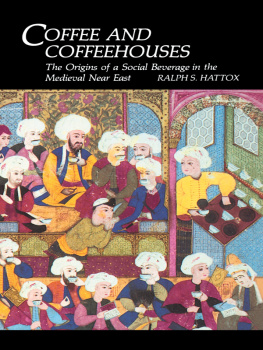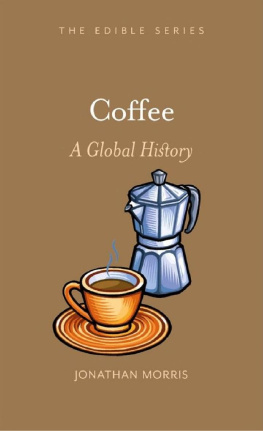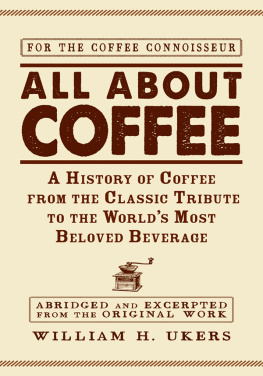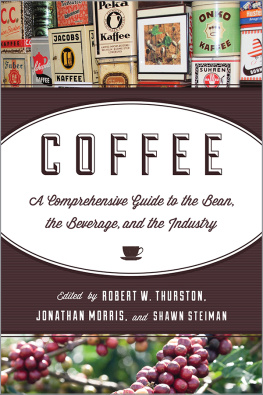Hattox - Coffee and coffeehouses: the origins of a social beverage in the medieval Near East
Here you can read online Hattox - Coffee and coffeehouses: the origins of a social beverage in the medieval Near East full text of the book (entire story) in english for free. Download pdf and epub, get meaning, cover and reviews about this ebook. City: Arabië;Midden-Oosten;Seattle, year: 1988, publisher: University of Washington Press, genre: Religion. Description of the work, (preface) as well as reviews are available. Best literature library LitArk.com created for fans of good reading and offers a wide selection of genres:
Romance novel
Science fiction
Adventure
Detective
Science
History
Home and family
Prose
Art
Politics
Computer
Non-fiction
Religion
Business
Children
Humor
Choose a favorite category and find really read worthwhile books. Enjoy immersion in the world of imagination, feel the emotions of the characters or learn something new for yourself, make an fascinating discovery.
Coffee and coffeehouses: the origins of a social beverage in the medieval Near East: summary, description and annotation
We offer to read an annotation, description, summary or preface (depends on what the author of the book "Coffee and coffeehouses: the origins of a social beverage in the medieval Near East" wrote himself). If you haven't found the necessary information about the book — write in the comments, we will try to find it.
Hattox: author's other books
Who wrote Coffee and coffeehouses: the origins of a social beverage in the medieval Near East? Find out the surname, the name of the author of the book and a list of all author's works by series.
Coffee and coffeehouses: the origins of a social beverage in the medieval Near East — read online for free the complete book (whole text) full work
Below is the text of the book, divided by pages. System saving the place of the last page read, allows you to conveniently read the book "Coffee and coffeehouses: the origins of a social beverage in the medieval Near East" online for free, without having to search again every time where you left off. Put a bookmark, and you can go to the page where you finished reading at any time.
Font size:
Interval:
Bookmark:

Cover illustration: Turkish miniature (detail): mid-sixteenth century. (Courtesy of the Trustees of the Chester Beatty Library)
Coffee and Coffeehouses was originally published in 1985 as No. 3 in Near Eastern Studies, University of Washington, sponsored by the Department of Near Eastern Languages and Civilization and the Middle East Center of the Henry M. Jackson School of International Studies, University of Washington.
Copyright 1985 by the Department of Near Eastern Languages and Civilization, University of Washington
University of Washington Press edition, 1988
Third printing, 1996
Printed in the United States of America
All rights reserved. No part of this publication may be reproduced or transmitted in any form or by any means, electronic or mechanical, including photocopy, recording, or any information storage or retrieval system, without permission in writing from the publisher.
Library of Congress Cataloging-in-Publication Data
Hattox, Ralph S.
Coffee and coffeehouses.
Reprint. Originally published: Seattle: Distributed by University of Washington Press, c1985. Originally published in series: Near Eastern studies, University of Washington: no. 3
Bibliography: p.
Includes index
1. CoffeeMiddle EastHistory. 2. Coffee-housesMiddle EastHistory. 3. CoffeeHistory. 4. Coffee-housesHistory. I. Title.
GT2919.M628H38 1988 394.1'2 8731618
ISBN 0295962313
The paper used in this publication meets the minimum requirements of American National Standard for Information SciencesPermanence of Paper for Printed Library Materials, ANSI Z39.481984.
ISBN-13: 978-0-295-80549-8 (electronic)
To my parents
I began writing this book some seven years ago as a short seminar paper at Princeton. Faced with the task of investigating the application of Islamic law to some specific question, I chose that of the prohibition of coffee. Starting with the knowledge that coffee was eventually found licit by the major schools of law, what remained was to examine the process of legal reasoning through which coffee was originally condemned, and how this condemnation was ultimately overturned. Several months of research led to the perplexing realization that coffee was eventually found licit because the original prohibition was not just faulty, but based on such flimsy claims that one had to wonder why they were put forward to begin with. If coffee itself patently fell within the group of legal beverages, there must be something with which it was associated that prompted all the furor. This work is an effort to discover what that something was.
A few methodological problems had to be tackled in dealing with the question. To begin with, while a fairamount of contemporary material exists concerning the coffee debate of the sixteenth century, which indeed forms the core of the work, much valuable material from a later age was found, and many of these works furnished detail that could be found in no other place. In light of this, I chose to depart in places from the sound principle of not judging the activities of a society by the writings about it from a later age. Lane's Manners and Customs, for example, suffers the dual disability of being of a much later time and of looking at the everyday life of Muammad Al's Egypt from an unabashedly European point of view. Nonetheless the detail Lane furnishes concerning the operation of coffeehouses in Cairo in his own day is simply too valuable to be overlooked. In those places where I do employ such later writers, I try to make it clear that we cannot necessarily interpret events of the sixteenth century by nineteenth-century evidence, and that such evidence must only be taken with this warning always in mind.
The focus of the work as well has some bearing on methodology. While archival materials have become the mainstay of studies concerned with the activities of states or officials, or with economic life, they are far more burdensome than fruitful to a work such as this, with its emphasis on mentalities, on the attitude of an entire society to the introduction of something entirely new to its fabric. The activities of the governments involved, and especially the economic impact of coffee in the Near East, deserve books of their own, and lie quite outside the scope of the present work.
I feel it necessary here to say a word or two about the system of transliteration I employ. For Turkish words, wherever possible, I prefer to use modern Turkish orthography, although at times I include extra diacritical marks to indicate the original spelling. For Arabic, I have tried to stick throughout to a somewhat modified version of the Libraryof Congress system of transliteration. I depart from this system in that, with nouns ending with a t marba that are not in construct with a following noun, I have chosen not to employ a potentially confusing (and to my mind ugly) final h. In addition, while I follow convention in dropping almost all inflectional endings from nouns, I have retained those denoting the indefinite accusative, particularly where this case is used adverbially. This ending I have retained in the form of a superscript an, for instance, majzan.
In the years since I began this work I have benefited greatly from the assistance of numerous institutions and individuals. First of all, I should like to acknowledge the help provided by the staffs of the following libraries, who provided me with microfilms and photocopies of manuscripts, and photographs of some of the illustrations used in this work: the Division of Rare Books, Library of Congress; the National Library of Medicine in Bethesda, Maryland, the Bibliothque nationale, Paris; the Escurial, Madrid; the Staatsbibliothek Preuischer Kulturbesitz, Berlin; the library of the Rijksuniversitet, Leiden; the Chester Beatty Library, Dublin; New York Public Library; and Princeton University Library. Special thanks go as well to Paul E. Chevedden, UCLA; Martha Dukas, Boston Public Library; Edward W. Earle, California Museum of Photography; George S. Hobart, Library of Congress; Mary Ellen Taylor, Harvard Semitic Museum; and Kristin Kinsey, Suzzallo Library, University of Washington.
I should also like to express my gratitude to the many teachers, colleagues, and friends who offered bibliographical suggestions and valuable comments on the numerous draft versions of this work, particularly Avrom Udovitch, Charles Issawi, Norman Itzkowitz, Bernard Lewis, the late Rudolf Mach, Halil nalcik, Lawrence Conrad, PaulaSanders, and Shaun Marmon. Thanks also go to Grace Edelman of the Department of Near Eastern Studies at Princeton for her support during much of the writing of the dissertation on which this book is based.
Finally, I wish to acknowledge a special debt to three people who were of tremendous assistance during the final stages of the preparation of this work: Daniel Goff-man, for his copious comments and criticisms of the original manuscript; John R. Coogan, whose critical eye has, I hope, kept my prose from drifting too far toward the purple; and above all, Felicia J. Hecker of the University of Washington Press for the care, attention, and seemingly boundless energy she has put into preparing this work for publication.
Coffee has never been a mere beverage. Some three centuries have passed since it became the overnight rage among the fashionable and witty in cities throughout Europe. Even in the late twentieth century, however, it has yet to be relegated to the ranks of the more pedestrian potions with which we quench our thirst or warm our insides. Little of coffee's original mystique has been worn off by centuries of familiarity.
Font size:
Interval:
Bookmark:
Similar books «Coffee and coffeehouses: the origins of a social beverage in the medieval Near East»
Look at similar books to Coffee and coffeehouses: the origins of a social beverage in the medieval Near East. We have selected literature similar in name and meaning in the hope of providing readers with more options to find new, interesting, not yet read works.
Discussion, reviews of the book Coffee and coffeehouses: the origins of a social beverage in the medieval Near East and just readers' own opinions. Leave your comments, write what you think about the work, its meaning or the main characters. Specify what exactly you liked and what you didn't like, and why you think so.







